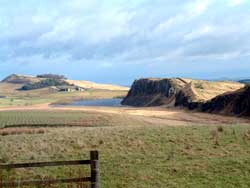
Click on the image for a larger version.
|
Image
details:
Hadrian’s Wall above Crag Lough. The
Wall runs along the crags above the Lough from the right.
It runs behind the farm (past milecastle 38), and rises up
Hotbank Crags.
Image ownership:
© Vindolanda Trust |
Only small areas of the pre-Hadrianic forts at Vindolanda have
been excavated. However plans of forts of this period are similar
enough to one another to use information from better known forts
to interpret the buildings excavated at Vindolanda, with the reservation
that no two forts are identical: hypothetical layouts must be tested
by future excavation.
The fort was built by soldiers themselves and housed a military
community that was in many respects self-contained. Its granaries
stored sufficient supplies to feed the garrison for many months.
From clay and stone for its fabric to grazing for pigs and cattle,
the fort drew heavily on its immediate environs. The facilities
and skills existed within the garrison to meet a large proportion
of its own needs, including food production and making and repairing
many types of item. A wide range of specialist skills is attested
in the Vindolanda garrison, from plastering to brewing, a diversity
previously thought more typical of the legions than the auxiliaries.
The variety of buildings, for example a bath-house, hospital and
temple, would otherwise be found only in larger urban communities.
But the fort was by no means totally self-sufficient and depended
on constant contact with the outside world. Supplies were regularly
on the move to Vindolanda. Nor did the soldiers remain in camp waiting
for the Britons to attack. Control of the frontier landscape was
based on movement, patrol and communication. Conditions were sufficiently
safe for the wife of the Vindolanda garrison commander to be invited
to her friend's birthday celebration at another fort. A merchant
moving a batch of hides was more concerned for the state of the
roads than marauding Britons. The movements of people and supplies
allowed a Roman lifestyle to be maintained, at least in the household
of the fort commander. The tablets reveal something of the tastes
and customs of the fort's inhabitants, in particular the 'Romanization'
of the officer class.
This area of the exhibition describes the setting in which the
soldiers recorded in the Vindolanda tablets lived their lives, outlining
the plan and the range of structures in a typical fort, using the
more extensively excavated, near contemporary fort at Wallsend in
Newcastle and the reconstructed fort at the Lunt, Warwickshire,
to illustrate these. The Latin terms for the different buildings
are briefly presented with a guide to fort layout. The activities
which filled soldiers' time are described. The Vindolanda tablets
have little direct evidence for wars or battles, but they give an
insight into the very flexible organisation and deployment of troops.
Documents and archaeology are used to show how the soldier's time
was also occupied with building, manufacture and repair, as well
as ensuring supplies to the fort. The later pages explore aspects
of daily life in the fort, including diet and dress and the evidence
for the social events and religious festivals that offered a diversion
from military routine.
Tablet database link: Browse all tablets related to military matters.
|